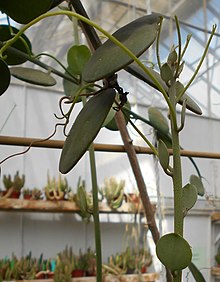
A cactus is a member of the plant family Cactaceae, a family comprising about 127 genera with some 1750 known species of the order Caryophyllales. The word "cactus" derives, through Latin, from the Ancient Greek κάκτος, kaktos, a name originally used by Theophrastus for a spiny plant whose identity is now not certain. Cacti occur in a wide range of shapes and sizes. Most cacti live in habitats subject to at least some drought. Many live in extremely dry environments, even being found in the Atacama Desert, one of the driest places on earth. Cacti show many adaptations to conserve water. Almost all cacti are succulents, meaning they have thickened, fleshy parts adapted to store water. Unlike many other succulents, the stem is the only part of most cacti where this vital process takes place. Most species of cacti have lost true leaves, retaining only spines, which are highly modified leaves. As well as defending against herbivores, spines help prevent water loss by reducing air flow close to the cactus and providing some shade. In the absence of leaves, enlarged stems carry out photosynthesis. Cacti are native to the Americas, ranging from Patagonia in the south to parts of western Canada in the north—except for Rhipsalis baccifera, which also grows in Africa and Sri Lanka.
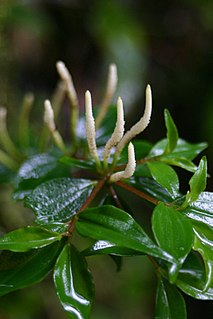
Peperomia is one of the two large genera of the family Piperaceae. Most of them are compact, small perennial epiphytes growing on rotten wood. More than 1500 species have been recorded, occurring in all tropical and subtropical regions of the world, though concentrated in Central America and northern South America. A limited number of species are found in Africa.

A vine is any plant with a growth habit of trailing or scandent stems, lianas or runners. The word vine can also refer to such stems or runners themselves, for instance, when used in wicker work.
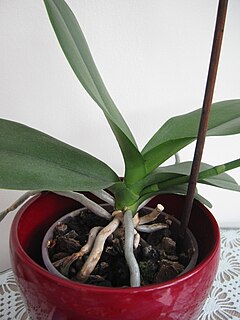
Vascular plants with monopodial growth habits grow upward from a single point. They add leaves to the apex each year and the stem grows longer accordingly. The word Monopodial is derived from Greek "mono-", one and "podial", "foot", in reference to the fact that monopodial plants have a single trunk or stem.
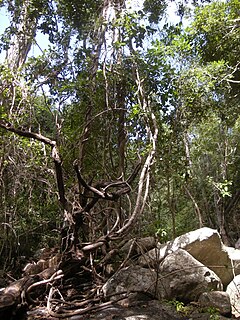
A liana is a long-stemmed, woody vine that is rooted in the soil at ground level and uses trees, as well as other means of vertical support, to climb up to the canopy in search of direct sunlight. Lianas are characteristic of tropical moist deciduous forests, but may be found in temperate rainforests and temperate deciduous forests. There are also temperate lianas, for example the members of the Clematis or Vitis genera. Lianas can form bridges amidst the forest canopy, providing arboreal animals with paths across the forest. These bridges can protect weaker trees from strong winds. Lianas compete with forest trees for sunlight, water and nutrients from the soil. Forests without lianas grow 150% more fruit; trees with lianas have twice the probability of dying.
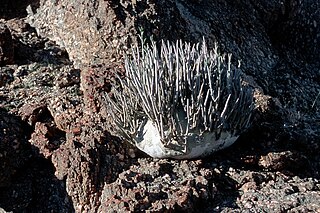
Adenia is a genus of flowering plants in the passionflower family, Passifloraceae. It is distributed in the Old World tropics and subtropics. The centers of diversity are in Madagascar, eastern and western tropical Africa, and Southeast Asia. The genus name Adenia comes from "aden", reported as the Arabic name for the plant by Peter Forsskål, the author of the genus.

Ceropegia woodii is a flowering plant in the genus Ceropegia (Apocynaceae), native to South Africa, Swaziland, and Zimbabwe. It is sometimes treated as a subspecies of the related Ceropegia linearis, as C. linearis subsp. woodii. Common names include chain of hearts, collar of hearts, string of hearts, rosary vine, hearts-on-a-string, and sweetheart vine.
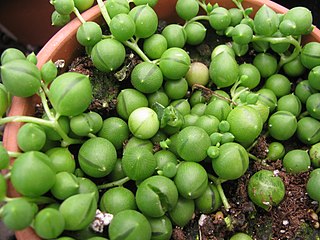
Curio rowleyanus, syn. Senecio rowleyanus, is a flowering plant in the daisy family Asteraceae. It is a creeping, perennial, succulent vine native to the drier parts of southwest Africa. In its natural environment its stems trail on the ground, rooting where they touch and forming dense mats. It often avoids direct sunlight by growing in the shade of other plants and rocks. It is commonly known as string-of-pearls or string-of-beads.
Plant life-form schemes constitute a way of classifying plants alternatively to the ordinary species-genus-family scientific classification. In colloquial speech, plants may be classified as trees, shrubs, herbs, etc. The scientific use of life-form schemes emphasizes plant function in the ecosystem and that the same function or "adaptedness" to the environment may be achieved in a number of ways, i.e. plant species that are closely related phylogenetically may have widely different life-form, for example Adoxa and Sambucus are from the same family, but the former is a small herbaceous plant and the latter is a shrub or tree. Conversely, unrelated species may share a life-form through convergent evolution.

In botany, succulent plants, also known as succulents, are plants with parts that are thickened, fleshy, and engorged, usually to retain water in arid climates or soil conditions. It is a characteristic that is not used scientifically for the definition of most families and genera of plants because it often can be used as an accurate characteristic only at the single species level. The word succulent comes from the Latin word sucus, meaning 'juice', or 'sap'. Succulent plants may store water in various structures, such as leaves and stems. The water content of some succulent organs can get up to 90-95%. Some definitions also include roots, thus geophytes that survive unfavorable periods by dying back to underground storage organs may be regarded as succulents. In horticultural use, the term succulent is sometimes used in a way that excludes plants that botanists would regard as succulents, such as cacti. Succulents are often grown as ornamental plants because of their striking and unusual appearance, as well as their ability to thrive with relatively minimal care.

The Cuban dry forests are a tropical dry forest ecoregion that occupies 65,800 km2 (25,400 sq mi) on Cuba and Isla de la Juventud. The ecoregion receives 1,000–2,000 mm (39–79 in) of rainfall annually. Cuban dry forests can be differentiated into evergreen forests, semi-deciduous forests, mogotes, and sclerophyllous low forests.

Smilax glauca, the cat greenbriar or catbriar is a woody vine in the family Smilacaceae. It is native to central and eastern portions of the United States, where it is a common and conspicuous part of the forest vegetation. It is also common across much of Mexico.

Aloiampelos gracilis, formerly Aloe gracilis, the rocket aloe, is a succulent plant, endemic to dry thicket vegetation around the city of Port Elizabeth, South Africa. Its natural range lies just to the west of the related Aloiampelos ciliaris, and it occurs in bushy fynbos and dry thickets, and clustered on rocky outcrops at all altitudes. Its range extends westwards into the Baviaanskloof mountains.
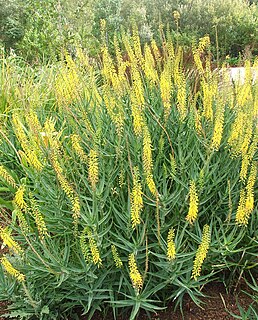
Aloiampelos, formerly Aloe ser. Macrifoliae is a genus of succulent plants in the subfamily Asphodeloideae, comprising seven species found in Southern Africa. They are typically multi-branched climbing or sprawling shrubs, with long spindly stems and a large woody base on the ground. These characteristics, as well as their soft, narrow, triangular leaves whose lower part ensheathes the stem, make them easy to distinguish.

Pereskia aculeata is a scrambling shrub in the family Cactaceae. Common names include Barbados gooseberry, blade-apple cactus, leaf cactus, rose cactus, and lemonvine. It is native to tropical America. The leaves and fruits are edible, containing high quantities of protein, iron and other nutrients, and it is a popular vegetable in parts of the Brazilian state of Minas Gerais under the name of ora-pro-nóbis.

The Stellenbosch University Botanical Garden located in the historical center of Stellenbosch is the oldest university botanical garden in South Africa. The Garden is relatively small and houses an enormous diversity of plants, both indigenous to South Africa and introduced species. It is open to the public.

Crassula ovata, commonly known as jade plant, lucky plant, money plant or money tree, is a succulent plant with small pink or white flowers that is native to the KwaZulu-Natal and Eastern Cape provinces of South Africa, and Mozambique; it is common as a houseplant worldwide. Much of its popularity stems from the low levels of care needed; the jade plant requires little water and can survive in most indoor conditions. It is sometimes referred to as the money tree; however, Pachira aquatica also has this nickname.

Cyphostemma mappia is a species of caudiciform succulent plant endemic to Mauritius. It is sometimes known as the "Mauritian baobab", though it is member of the grape family (Vitaceae) and unrelated to the true Baobabs of Africa.
Vitex thyrsiflora is a species of woody vine in the family Lamiaceae. It is native to tropical West and Central Africa. Its hollow stem is used as a home by an aggressive species of ant.
Senecio cotyledonis ("Stinkbos") is a species of succulent flowering plant in the aster family, indigenous to the Western Cape and Northern Cape, South Africa.
